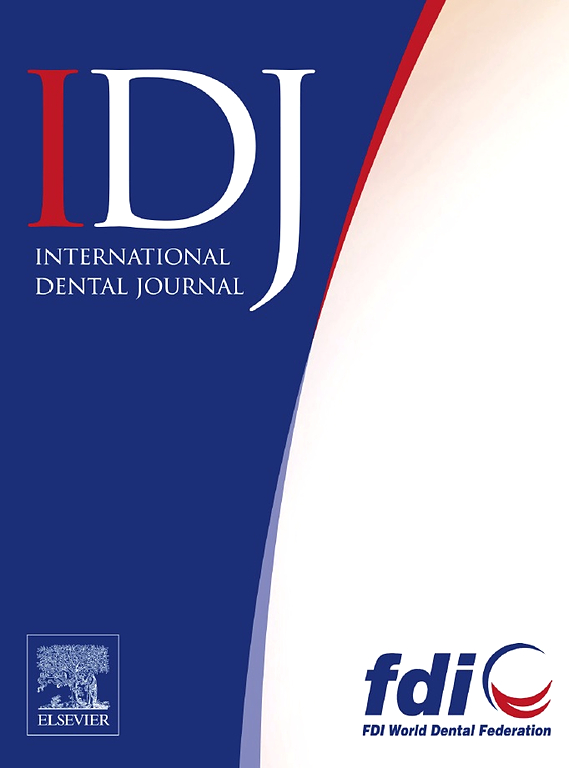Global Burden of Oral Diseases in Adolescents and Young Adults Aged 10–24 Years
IF 3.2
3区 医学
Q1 DENTISTRY, ORAL SURGERY & MEDICINE
引用次数: 0
Abstract
Objectives
This study aims to analyse global trends in the burden of oral diseases, including dental caries and noncarious oral diseases (NCODs), in individuals aged 10 to 24 from 1990 to 2021 and project future trends up to 2050.
Methods
Using data from the Global Burden of Disease Study (GBD) 2021, this trend analysis examines the number, age-standardised rates (ASRs), and average annual percentage changes (AAPCs) in prevalence, incidence, and disability-adjusted life years for oral diseases across different age groups, sexes, social-development index (SDI) levels, regions, and nations. Joinpoint regression was applied to identify key inflection points, while Bayesian modelling was used to project future trends.
Results
Globally, the ASR of oral disease prevalence slightly decreased from 35,408 per 100,000 populations (95% CI: 25,412-47,171) in 1990 to 34,004 per 100,000 population (95% CI: 25,255-44,634) in 2021, with an AAPC of –0.13 (95% CI: –0.16 to –0.10). Dental caries saw a reduction in prevalence and burden, while NCODs increased. Males experienced a faster decline than females, who consistently had higher prevalence and burden. Adolescents aged 10 to 14 years showed the most significant decline. Central Europe experienced the most significant regional reduction, while Greece saw the largest national decline in the prevalence of oral diseases. Higher SDI strata were associated with lower prevalence, with high-SDI countries showing the greatest decline. Projections indicate a slight decrease in prevalence by 2050, with the overall burden remaining unchanged.
Conclusions
Despite the decline in prevalence, the burden of oral diseases remains, highlighting the need for more effective prioritisation of oral health care for adolescents and young adults.
Clinical Significance
The persistent burden of oral diseases and disparities in oral health are evident across different sexes, age groups, SDI levels, regions, and nations. This highlights the ongoing need for increased attention to oral health among adolescents and young adults, particularly for females, older adolescents, and those in low- and middle-income countries.
10-24岁青少年和年轻人的全球口腔疾病负担
本研究旨在分析1990年至2021年10至24岁人群口腔疾病负担的全球趋势,包括龋齿和非龋齿口腔疾病(NCODs),并预测到2050年的未来趋势。方法使用全球疾病负担研究(GBD) 2021的数据,该趋势分析检查了不同年龄组、性别、社会发展指数(SDI)水平、地区和国家的口腔疾病患病率、发病率和残疾调整生命年的数量、年龄标准化率(asr)和平均年百分比变化(AAPCs)。接合点回归用于识别关键拐点,而贝叶斯模型用于预测未来趋势。在全球范围内,口腔疾病患病率的ASR从1990年的35,408 / 10万人(95% CI: 25,412-47,171)略微下降到2021年的34,004 / 10万人(95% CI: 25,255-44,634), AAPC为-0.13 (95% CI: -0.16 - -0.10)。龋齿的患病率和负担有所下降,而非致死病例有所增加。男性比女性下降得更快,女性的患病率和负担一直较高。10至14岁的青少年表现出最显著的下降。中欧的区域减少幅度最大,而希腊的国家口腔疾病患病率下降幅度最大。较高的SDI层与较低的患病率相关,高SDI国家的下降幅度最大。预测表明,到2050年患病率将略有下降,总体负担保持不变。结论尽管患病率有所下降,但口腔疾病的负担仍然存在,这突出表明需要更有效地优先考虑青少年和年轻人的口腔卫生保健。口腔疾病的持续负担和口腔健康的差异在不同的性别、年龄组、SDI水平、地区和国家中都是明显的。这突出表明,目前需要更多地关注青少年和青壮年的口腔健康,特别是女性、年龄较大的青少年以及低收入和中等收入国家的青少年。
本文章由计算机程序翻译,如有差异,请以英文原文为准。
求助全文
约1分钟内获得全文
求助全文
来源期刊

International dental journal
医学-牙科与口腔外科
CiteScore
4.80
自引率
6.10%
发文量
159
审稿时长
63 days
期刊介绍:
The International Dental Journal features peer-reviewed, scientific articles relevant to international oral health issues, as well as practical, informative articles aimed at clinicians.
 求助内容:
求助内容: 应助结果提醒方式:
应助结果提醒方式:


